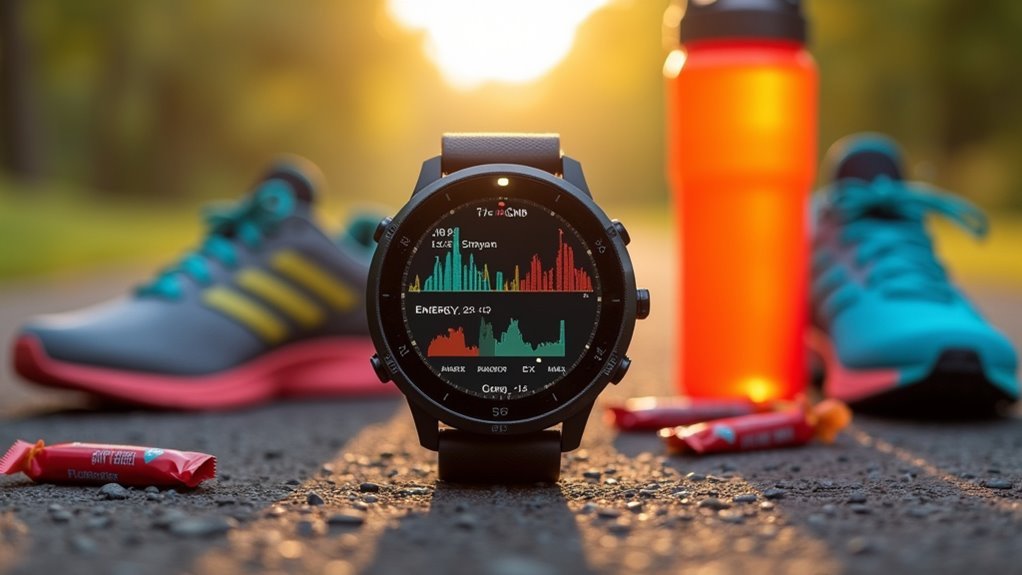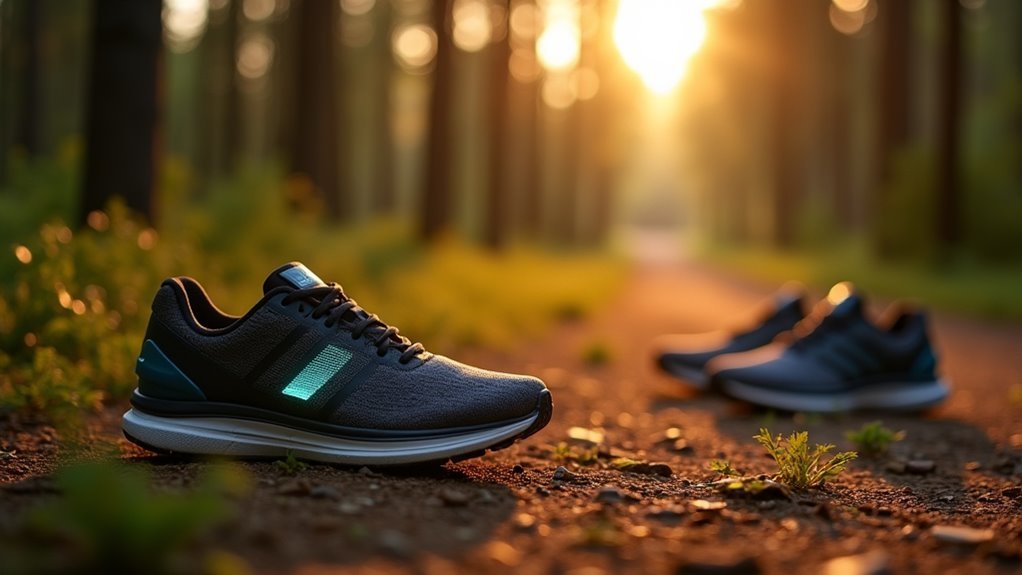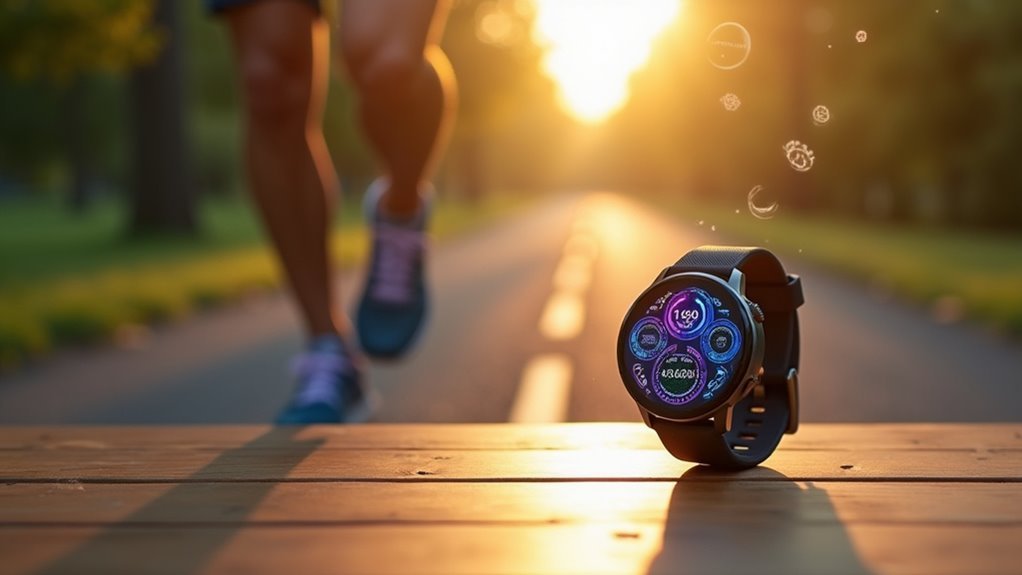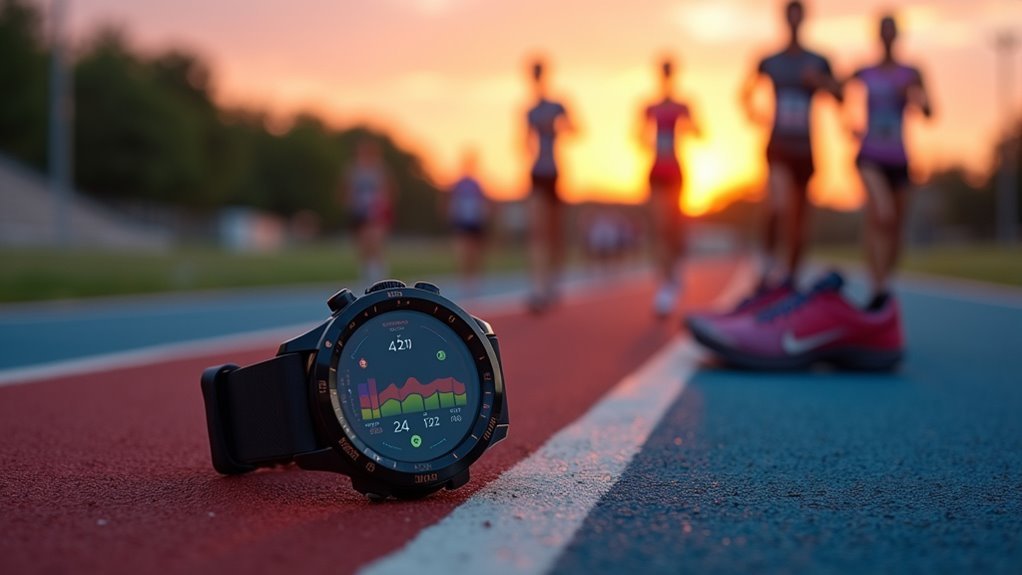You’ll find the perfect running watch app by prioritizing GPS accuracy, heart rate monitoring, and customizable data fields that match your training needs. Popular options like Strava, Nike Run Club, and Garmin Connect+ offer everything from basic distance tracking to advanced biomechanical analysis. Consider apps with social features for motivation, safety tools like emergency SOS, and battery optimization settings for longer runs. Multi-sport functionality and smartphone integration enhance versatility, while premium subscriptions reveal coaching features that’ll transform your training approach.
Essential Features Every Running Watch App Should Have

When you’re selecting a running watch app, you’ll want to prioritize features that enhance both your performance and overall running experience.
Heart rate monitoring should be non-negotiable, as it provides real-time insights into your workout intensity and helps prevent overexertion. GPS route tracking is equally essential for mapping distances and analyzing your running patterns over time.
Real-time heart rate data and GPS tracking form the foundation of effective running performance analysis and safety.
Look for apps that offer basic health metrics like sleep tracking and calorie burn estimation to support your overall wellness goals.
Multi-sport functionality adds versatility if you cross-train with cycling or swimming. Training recommendations based on your current fitness level will help you progress systematically, while customizable data fields guarantee you can view the metrics that matter most during your runs. Consider choosing watches with battery life of at least a week to avoid frequent charging interruptions during your training routine.
Top-Rated GPS Running Apps for Accurate Distance Tracking
You’ll want GPS running apps that deliver pinpoint accuracy for distance tracking, whether you’re using your smartphone or syncing with your running watch.
The best apps combine reliable GPS technology with seamless smartphone integration, giving you real-time metrics and detailed post-run analysis.
Let’s explore the top-rated options that excel at accurate distance measurement and offer the essential features serious runners demand. These apps also track your progress during recovery day activities like walks and bike rides to help maintain your fitness routine between intense running sessions.
Essential GPS Accuracy Features
Most GPS running watches deliver distance tracking accuracy within a 1-3% error margin under typical conditions, but several key features separate the top-rated models from basic alternatives.
You’ll want multi-band GPS support with multiple GNSS systems like GPS, GLONASS, and Galileo for enhanced satellite reception in challenging environments. Look for watches that combine barometric altimeters with GPS to improve elevation accuracy during your runs.
Advanced algorithm processing makes a significant difference—manufacturers use proprietary methods that affect how distance, pace, and elevation data are calculated.
Features like Suunto’s “Snap to Route” functionality allow you to preload GPX race routes, reducing location errors by aligning tracking to known courses.
These sophisticated features guarantee more reliable data whether you’re running through urban canyons or dense forest trails. Comprehensive testing by experts has evaluated over 50 GPS watches across diverse environments to verify accuracy performance under real-world conditions.
Popular Distance Tracking Apps
While dedicated GPS watches provide excellent hardware-based tracking, smartphone apps offer compelling alternatives that leverage your phone’s built-in GPS capabilities alongside robust social features and advanced analytics.
Strava dominates with its competitive segments feature, letting you race others on identical routes while offering thorough tracking across multiple activities. The premium Beacon feature adds safety through real-time location sharing.
Nike Run Club delivers free guided runs and coaching plans with motivational badges and challenges, syncing seamlessly with Apple Watch and Garmin devices.
Runkeeper excels at multi-activity tracking beyond running, offering gamified challenges and extensive device compatibility.
Adidas Running provides customizable audio feedback and gear tracking to monitor shoe wear.
MapMyRun stands out with 70 million user-created routes for endless exploration possibilities. The app automatically saves your run details including speed, elevation, and distance without requiring additional input.
Smartphone Integration Benefits
Since smartphones have become powerful computing devices with advanced GPS capabilities, they offer significant advantages for distance tracking that many runners overlook.
You’ll find smartphones provide superior GPS accuracy compared to dedicated running watches while delivering exceptional cost-effectiveness since you only need a free running app.
Your smartphone’s multifunctionality eliminates carrying multiple devices. It serves as your camera, music player, and connects seamlessly to heart rate monitors and footpods.
You can run multiple apps simultaneously, accessing real-time pace tracking, route mapping, and detailed workout analysis.
Integration with wearables enhances your experience through reduced bulk and extended battery life. Your smartwatch displays data conveniently while your phone handles the heavy processing.
You’ll also benefit from safety features like emergency calling and location sharing with family. However, proper device positioning is crucial for optimal GPS performance, as clipping the phone to your waistband may reduce accuracy compared to holding it in hand or strapping it to your upper arm.
Social and Community-Driven Running Platforms
Your running journey becomes more engaging when you tap into social platforms that connect you with fellow runners worldwide.
These community-driven apps boost your motivation through group challenges, leaderboards, and shared achievements that turn solo runs into collaborative experiences.
You’ll find that sharing your progress, participating in virtual races, and celebrating milestones with others creates accountability that keeps you lacing up your shoes consistently. With Millennials (69.2%) being the most active demographic on social media, running apps increasingly leverage these platforms to create vibrant communities where experienced runners mentor newcomers and share training insights.
Community Motivation Features
The power of community transforms solitary running into a shared journey that keeps you motivated mile after mile.
Your running watch app’s community features create the social framework that turns individual workouts into shared experiences.
Activity sharing lets you post workouts, streaks, and achievements directly to social feeds or dedicated community boards.
Real-time leaderboards foster friendly competition among peers while personalized AI-driven challenges tailor goals based on your history and community trends.
You’ll stay engaged through comment and interaction features that let you like, react to, and comment on others’ activities.
Group event coordination becomes seamless with built-in calendars and notifications for community runs, virtual races, and challenges.
These features transform your running watch from a solo tracking device into a powerful community connector. Major manufacturers recognize this shift, with social interaction features becoming a significant market trend as brands like Garmin, Suunto, and Polar enhance user engagement through connected experiences.
Group Challenges Benefits
Eighty-nine percent of runners report increased happiness when participating in group challenges through platforms like ParkRun and Strava, transforming what could be a solitary pursuit into a powerful catalyst for both physical and mental well-being.
You’ll discover that group challenges provide enhanced accountability, keeping you committed to your running routine through collective motivation. The social connections you’ll build reduce isolation while fostering emotional support that helps you cope with life’s stresses more effectively.
These challenges greatly improve your consistency by tapping into competitive elements and shared goals. You’ll experience mood enhancement from endorphin release combined with meaningful social interactions.
The resilience you’ll build pushes you beyond perceived limits, while the sense of belonging strengthens your mental health foundation, creating lasting positive changes in your overall wellness journey. Group fitness challenges also help prevent you from slipping back into sedentary habits by maintaining consistent engagement with your running community.
Social Sharing Impact
When you share your running achievements on social platforms, you’re tapping into one of the most powerful motivators for sustained fitness behavior. Over 69% of users willingly share their fitness data with friends and family, creating accountability networks that drive consistency.
Social sharing transforms your running routine through three key mechanisms:
- Enhanced accountability – knowing others monitor your progress increases commitment
- Social facilitation – you naturally adjust performance when comparing to peers
- Positive reinforcement – community feedback creates encouraging loops for continued effort
Running watch apps leverage these psychological drivers through leaderboards, friend connections, and daily progress sharing. Your shared metrics become conversation starters and motivation boosters within your network.
However, users who feel they need external support for exercise may find that this need for support actually creates barriers to consistent wearable health tracker engagement rather than enhancing it.
As social running platforms expand, with market projections showing near doubling by 2035, these community-driven features increasingly determine long-term app engagement and fitness success.
Safety Features That Keep Runners Protected
Modern running watches have evolved beyond simple timekeeping devices to become extensive safety companions that can literally save your life during outdoor workouts.
Fall detection features automatically alert emergency services when you’ve taken a hard tumble, while Emergency SOS lets you call for help directly from your wrist without needing your phone nearby.
Location sharing keeps your loved ones informed of your whereabouts during runs, and collision alerts notify emergency contacts if you’re involved in a serious accident. However, it’s important to understand that law enforcement requests can access this location data from companies when legally required, which affects the absolute privacy of your tracking information.
Advanced models include siren alarms for additional protection in dangerous situations.
Heart health monitoring adds another safety layer through ECG sensors and abnormal rhythm detection, alerting you to potential cardiac issues before they become life-threatening emergencies.
Battery Life Optimization for Extended Running Sessions

Although your running watch’s safety features provide essential protection, they mean nothing if your device dies mid-run during a marathon or ultra-distance event. Maximizing battery life requires strategic sacrifices without compromising essential data.
Dead batteries turn essential safety features into useless weight during critical moments when you need them most.
Start by adjusting GPS frequency – switch from 1-second fixes to 5-10 second intervals for running, or use UltraTrac mode for ultra-distance events. This single change can double your battery life from 20 to 50 hours. Consider that entry-level watches typically last only 8-10 hours while premium models can extend to 200 hours, making the investment worthwhile for serious endurance athletes.
Next, optimize your display settings:
- Reduce screen brightness to minimum (5%)
- Set backlight timeout to 4 seconds
- Disable gesture-activated backlight
Finally, disable non-essential features like Bluetooth connectivity, heart rate monitoring, notifications, and music controls.
Create custom battery profiles that automatically toggle these settings for long runs, ensuring you’ll cross the finish line with data intact.
Cross-Platform Compatibility and Device Integration
You’ll want your running data seamlessly accessible across all your devices, from your smartwatch to your smartphone to your tablet.
Modern running apps excel at multi-device synchronization, automatically syncing your workout data through cloud services so you can start a run on your watch and analyze the results on your phone immediately afterward.
The best apps integrate deeply with your smartphone’s ecosystem, pulling health data from platforms like Apple Health or Google Fit while pushing your running metrics back to create a thorough fitness profile. These integrations allow you to earn heart points based on your activity intensity, providing additional motivation to maintain consistent training routines.
Multi-Device Sync Options
When choosing a running watch app, cross-platform compatibility guarantees you won’t lose functionality if you switch devices or want to use multiple gadgets simultaneously.
Multi-device sync facilitates your running data stays consistent across all platforms through cloud-based synchronization.
Key sync features you’ll benefit from include:
- Step and GPS tracking – Your distance, pace, and route data automatically transfers between devices.
- Heart rate monitoring – Real-time biometric data syncs from smartwatches to your phone app.
- Workout plans – Personalized training schedules remain accessible whether you’re using your watch, phone, or tablet.
Apps like Stridekick support most major fitness trackers including Fitbit, Garmin, and Apple devices, while Runkeeper works seamlessly with both Wear OS and Apple Watch. Android users with OS 5.0 or above can enhance their integration through the Health Connect app for improved cross-device functionality.
This flexibility lets you choose devices based on preference rather than app limitations.
Smartphone App Integration
Modern running watch ecosystems extend far beyond the device on your wrist, as manufacturers design extensive smartphone apps that serve as command centers for your fitness data.
You’ll find major brands like Garmin, Suunto, and Coros offering companion apps for both iOS and Android, while Apple Fitness remains exclusive to iOS users. These apps automatically sync your run data, displaying detailed metrics including pace, distance, heart rate, and VO2max through intuitive interfaces optimized for quick access.
Your smartphone app becomes your gateway to advanced features like route mapping, training plans, and music control. Many watches also track workouts beyond running and include features like contactless payment and music streaming.
You can customize alerts, download offline maps, and manage firmware updates directly through these companion apps, creating a seamless integration between your watch and mobile device.
Premium Subscription Services Worth the Investment

As running technology advances, premium subscription services have emerged as powerful tools that can transform your training experience beyond what standard free apps offer. Garmin Connect+ exemplifies this evolution, providing AI-powered features and personalized marathon plans for $6.99 monthly or $69 annually.
Premium running subscriptions like Garmin Connect+ deliver AI-powered coaching and personalized training that free apps simply cannot match.
You’ll access advanced metrics including HRV, stress tracking, and VO2 Max analysis that optimize your performance through data-driven insights. The service integrates seamlessly with Garmin watches like the Fenix 8 and Forerunner 265, while maintaining compatibility across iOS and Android platforms.
Here’s what makes premium subscriptions worthwhile:
- AI-driven personalized coaching tailored to your specific goals and performance data
- Advanced recovery insights that prevent overtraining and optimize rest periods
- Custom workout planning with real-time progress tracking and adaptive training recommendations
For serious runners invested in the Garmin ecosystem, these premium features justify the investment. The subscription includes access to structured workouts with detailed exercise animations and guidance, making it particularly effective for indoor training sessions.
Beginner-Friendly Apps With Guided Training Plans
While premium subscriptions offer advanced features for dedicated athletes, new runners need apps that focus on accessibility and guided progression rather than complex analytics.
Strava’s free version provides essential tracking with optional paid upgrades, while Runkeeper delivers beginner-friendly GPS workouts. Nike Run Club excels at motivation through guided runs and coaching tips, and Map My Run helps build consistent habits with route tracking.
For personalized training, Runna stands out with AI-tailored programs from 5K to ultras. It automatically adjusts mileage and pace based on your performance while providing holistic support including form advice and nutrition guidance.
Its couch-to-5K plan gradually improves fitness while minimizing injury risk. The Couch to 5K approach provides structured guidance specifically designed for those new to running with strong community support for enhanced motivation.
Look for apps offering structured weekly schedules, strength training elements, recovery guidance, and motivational support to sustain your running journey.
Advanced Analytics for Competitive Athletes
Competitive runners require sophisticated metrics beyond basic pace and distance tracking to optimize their performance and training protocols. Advanced running watches deliver extensive biomechanical analysis including ground contact time, vertical oscillation, cadence, and stride asymmetry without additional sensors. These metrics receive grading systems that guide technical improvements in your running form.
Your watch calculates composite performance scores across different training domains:
- Hill Score – Measures your climbing strength and power output on inclines
- Endurance Score – Evaluates aerobic capacity and sustained effort capabilities
- Training Status – Assesses current fitness level and recovery needs
Race predictors use accumulated training data to estimate finish times for various distances, while training load advisors prevent overtraining through heart rate variability analysis and personalized recovery recommendations. For more comprehensive running dynamics data, compatible accessories connect through the ANT+ protocol to expand your analytical capabilities.
Multi-Sport Functionality Beyond Running
Modern running watches have evolved into extensive fitness companions that extend far beyond single-sport tracking. You’ll find dedicated activity modes for cycling, swimming, skiing, and even specialized climbing features for multi-pitch routes. These watches automatically adjust metrics and insights based on your chosen sport, whether you’re tackling whitewater rapids or hitting the slopes.
| Land Sports | Water Sports | Winter Sports |
|---|---|---|
| Trail Running | Pool Swimming | Alpine Skiing |
| Road Cycling | Open Water | Snowboarding |
| Mountain Biking | Rowing | Cross-Country |
| Rock Climbing | Whitewater | Snowshoeing |
| Hiking | Surfing | Ice Climbing |
Your watch seamlessly shifts between activities, providing tailored data for each sport while maintaining thorough fitness tracking across all your adventures. Top-rated models feature multi-band GPS technology that maintains accuracy within 1-3% of measured distances across all these varied activities.
Choosing the Right App Ecosystem for Your Watch Brand
How do you navigate the maze of running watch ecosystems when each brand offers its own suite of apps and features? Your choice considerably impacts your long-term running experience, so understanding each platform’s strengths is essential.
Garmin Connect stands out with thorough data analysis, extensive third-party integrations, and robust social features like challenges and badges. You’ll get detailed performance metrics including VO2 max and real-time stamina estimates, plus the ability to connect with friends and join community events.
Coros offers a more streamlined approach with user-friendly interfaces and quick data sync, though it lacks Garmin’s analytical depth. The platform delivers exceptional battery performance with around 30 days of regular use on their newer models.
Consider these key factors when choosing:
- Data complexity needs – detailed analysis vs. simple visualizations
- Social engagement preferences – community features vs. basic sharing
- Third-party integration requirements – extensive app support vs. core functionality
Frequently Asked Questions
Can Running Watch Apps Work Offline Without Internet Connection?
You can use many running watch apps offline for GPS tracking, but you’ll face limited features like no route planning or social sharing. You’ll need internet later to sync your data.
How Do Running Apps Handle Data Privacy and Location Information?
Running apps collect your location data and personal information to provide tracking features. You’ll face mandatory consent scenarios, but you can configure privacy settings to limit data sharing with third parties and advertisers.
What Happens to My Running Data if I Switch Apps?
You’ll need to export your data before switching apps. Most apps support .gpx, .fit, or .tcx formats for transfer, though some features won’t carry over and premium subscriptions may be required.
Do Running Watch Apps Drain Smartphone Battery During Workouts?
Running watch apps minimally drain your smartphone’s battery during workouts since they primarily run on your watch. However, frequent notification syncing and continuous Bluetooth connectivity can cause some battery consumption.
Can Multiple Users Share One Running App Account on Different Devices?
You can share one running app account across multiple devices, but you’ll face limitations like unpairing watches, switching accounts manually, and potential data syncing issues between different platforms and users.
In Summary
You’ve explored the essential features, GPS accuracy, community aspects, safety tools, battery optimization, beginner guidance, advanced analytics, multi-sport capabilities, and ecosystem compatibility. Now you’re equipped to make an informed decision about your running watch app. Consider your specific needs, running goals, and watch brand when making your final choice. Don’t forget to test different apps during shorter runs before committing to longer training sessions. Your perfect running companion awaits.





Leave a Reply